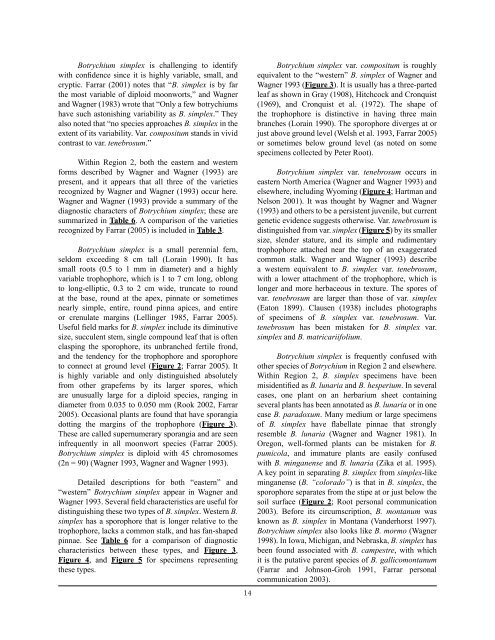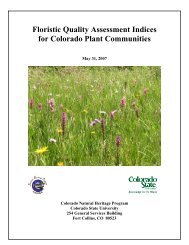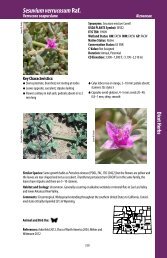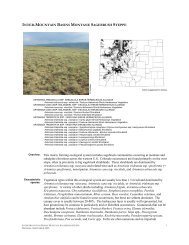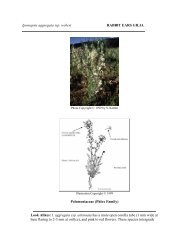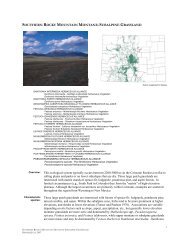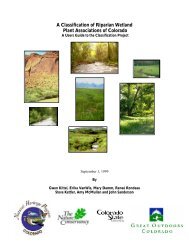Botrychium simplex E. Hitchcock (little grapefern) - Colorado Natural ...
Botrychium simplex E. Hitchcock (little grapefern) - Colorado Natural ...
Botrychium simplex E. Hitchcock (little grapefern) - Colorado Natural ...
Create successful ePaper yourself
Turn your PDF publications into a flip-book with our unique Google optimized e-Paper software.
<strong>Botrychium</strong> <strong>simplex</strong> is challenging to identify<br />
with confidence since it is highly variable, small, and<br />
cryptic. Farrar (2001) notes that “B. <strong>simplex</strong> is by far<br />
the most variable of diploid moonworts,” and Wagner<br />
and Wagner (1983) wrote that “Only a few botrychiums<br />
have such astonishing variability as B. <strong>simplex</strong>.” They<br />
also noted that “no species approaches B. <strong>simplex</strong> in the<br />
extent of its variability. Var. compositum stands in vivid<br />
contrast to var. tenebrosum.”<br />
Within Region 2, both the eastern and western<br />
forms described by Wagner and Wagner (1993) are<br />
present, and it appears that all three of the varieties<br />
recognized by Wagner and Wagner (1993) occur here.<br />
Wagner and Wagner (1993) provide a summary of the<br />
diagnostic characters of <strong>Botrychium</strong> <strong>simplex</strong>; these are<br />
summarized in Table 6. A comparison of the varieties<br />
recognized by Farrar (2005) is included in Table 3.<br />
<strong>Botrychium</strong> <strong>simplex</strong> is a small perennial fern,<br />
seldom exceeding 8 cm tall (Lorain 1990). It has<br />
small roots (0.5 to 1 mm in diameter) and a highly<br />
variable trophophore, which is 1 to 7 cm long, oblong<br />
to long-elliptic, 0.3 to 2 cm wide, truncate to round<br />
at the base, round at the apex, pinnate or sometimes<br />
nearly simple, entire, round pinna apices, and entire<br />
or crenulate margins (Lellinger 1985, Farrar 2005).<br />
Useful field marks for B. <strong>simplex</strong> include its diminutive<br />
size, succulent stem, single compound leaf that is often<br />
clasping the sporophore, its unbranched fertile frond,<br />
and the tendency for the trophophore and sporophore<br />
to connect at ground level (Figure 2; Farrar 2005). It<br />
is highly variable and only distinguished absolutely<br />
from other <strong>grapefern</strong>s by its larger spores, which<br />
are unusually large for a diploid species, ranging in<br />
diameter from 0.035 to 0.050 mm (Rook 2002, Farrar<br />
2005). Occasional plants are found that have sporangia<br />
dotting the margins of the trophophore (Figure 3).<br />
These are called supernumerary sporangia and are seen<br />
infrequently in all moonwort species (Farrar 2005).<br />
<strong>Botrychium</strong> <strong>simplex</strong> is diploid with 45 chromosomes<br />
(2n = 90) (Wagner 1993, Wagner and Wagner 1993).<br />
Detailed descriptions for both “eastern” and<br />
“western” <strong>Botrychium</strong> <strong>simplex</strong> appear in Wagner and<br />
Wagner 1993. Several field characteristics are useful for<br />
distinguishing these two types of B. <strong>simplex</strong>. Western B.<br />
<strong>simplex</strong> has a sporophore that is longer relative to the<br />
trophophore, lacks a common stalk, and has fan-shaped<br />
pinnae. See Table 6 for a comparison of diagnostic<br />
characteristics between these types, and Figure 3,<br />
Figure 4, and Figure 5 for specimens representing<br />
these types.<br />
14<br />
<strong>Botrychium</strong> <strong>simplex</strong> var. compositum is roughly<br />
equivalent to the “western” B. <strong>simplex</strong> of Wagner and<br />
Wagner 1993 (Figure 3). It is usually has a three-parted<br />
leaf as shown in Gray (1908), <strong>Hitchcock</strong> and Cronquist<br />
(1969), and Cronquist et al. (1972). The shape of<br />
the trophophore is distinctive in having three main<br />
branches (Lorain 1990). The sporophore diverges at or<br />
just above ground level (Welsh et al. 1993, Farrar 2005)<br />
or sometimes below ground level (as noted on some<br />
specimens collected by Peter Root).<br />
<strong>Botrychium</strong> <strong>simplex</strong> var. tenebrosum occurs in<br />
eastern North America (Wagner and Wagner 1993) and<br />
elsewhere, including Wyoming (Figure 4; Hartman and<br />
Nelson 2001). It was thought by Wagner and Wagner<br />
(1993) and others to be a persistent juvenile, but current<br />
genetic evidence suggests otherwise. Var. tenebrosum is<br />
distinguished from var. <strong>simplex</strong> (Figure 5) by its smaller<br />
size, slender stature, and its simple and rudimentary<br />
trophophore attached near the top of an exaggerated<br />
common stalk. Wagner and Wagner (1993) describe<br />
a western equivalent to B. <strong>simplex</strong> var. tenebrosum,<br />
with a lower attachment of the trophophore, which is<br />
longer and more herbaceous in texture. The spores of<br />
var. tenebrosum are larger than those of var. <strong>simplex</strong><br />
(Eaton 1899). Clausen (1938) includes photographs<br />
of specimens of B. <strong>simplex</strong> var. tenebrosum. Var.<br />
tenebrosum has been mistaken for B. <strong>simplex</strong> var.<br />
<strong>simplex</strong> and B. matricariifolium.<br />
<strong>Botrychium</strong> <strong>simplex</strong> is frequently confused with<br />
other species of <strong>Botrychium</strong> in Region 2 and elsewhere.<br />
Within Region 2, B. <strong>simplex</strong> specimens have been<br />
misidentified as B. lunaria and B. hesperium. In several<br />
cases, one plant on an herbarium sheet containing<br />
several plants has been annotated as B. lunaria or in one<br />
case B. paradoxum. Many medium or large specimens<br />
of B. <strong>simplex</strong> have flabellate pinnae that strongly<br />
resemble B. lunaria (Wagner and Wagner 1981). In<br />
Oregon, well-formed plants can be mistaken for B.<br />
pumicola, and immature plants are easily confused<br />
with B. minganense and B. lunaria (Zika et al. 1995).<br />
A key point in separating B. <strong>simplex</strong> from <strong>simplex</strong>-like<br />
minganense (B. “colorado”) is that in B. <strong>simplex</strong>, the<br />
sporophore separates from the stipe at or just below the<br />
soil surface (Figure 2; Root personal communication<br />
2003). Before its circumscription, B. montanum was<br />
known as B. <strong>simplex</strong> in Montana (Vanderhorst 1997).<br />
<strong>Botrychium</strong> <strong>simplex</strong> also looks like B. mormo (Wagner<br />
1998). In Iowa, Michigan, and Nebraska, B. <strong>simplex</strong> has<br />
been found associated with B. campestre, with which<br />
it is the putative parent species of B. gallicomontanum<br />
(Farrar and Johnson-Groh 1991, Farrar personal<br />
communication 2003).


